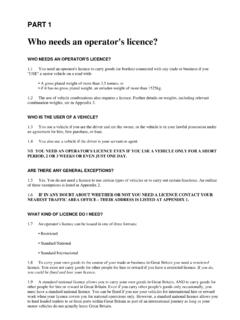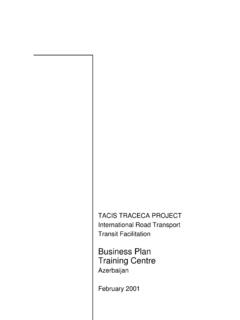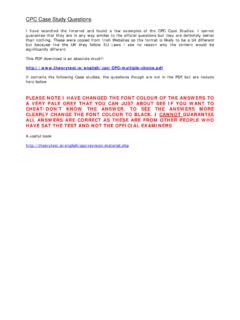Transcription of Agricultural or General Haulage
1 JCB Fastrac in Heavy Goods Vehicle Applications Agricultural or General Haulage ? Alan Mendelson JCB Consultant Introduction The JCB Fastrac is an instantly recognisable modern Agricultural tractor. It is fully type approved for sale in all European Member States as a Category T1 tractor with a maximum speed of 40 km/h and is also sold with a higher maximum speed where high speed tractors are permitted. Fastrac is offered with a range of engines that have a power out put between 160 to 260 hp. It has a cab that provides all the comforts of a modern workplace suitable for an 8 hour day and offers maximum safety in the event of an unfortunate accident.
2 All models are equipped with full four wheel suspension and a braking system that provides heavy goods vehicle (HGV) performance including an anti lock facility for added safety. As well as having suspension and brakes that meet the requirements for an HGV, the Fastrac meets all the other primary safety requirements for a road vehicle lights and tyres. Differences between Agricultural and Road Use As an Agricultural vehicle conventional tractors are granted many exemptions from the requirements of the Road Vehicle (Construction and Use) Regulations provided that they are not driven at speeds in excess of 20 mph.
3 They can be designed and manufactured without suspension, they can have a basic hydraulic steering system and are permitted to be braked on only the rear axle. These vehicles are authorised to tow trailers, including unbalanced (semi) trailers, which may impose a three tonne load on the rear axle of the tractor. Depending upon axle configuration an Agricultural tractor can legally tow a trailer with a maximum weight of 18290 kg within a maximum combination weight of 24390 kg. Various other UK legislation introduced by HMRC, VOSA and DVLA control the distance that an Agricultural tractor can be used on the road.
4 The Goods Vehicles (Licensing of Operators) Regulations 1995 includes an exemption for Agricultural tractors to be listed on an Operators O licence. These Regulations permit crops to be hauled over any distance from the field to a store or up to 15 miles as produce. If produce is moved a distance greater than 15 miles then at least a Restricted O Licence may be required. JCB Fastrac with a typical Agricultural semi trailer 1 By comparison the Heavy Goods Vehicle has to comply with many regulations to ensure safe and robust design and construction standards. Prior to entering service all HGVs, motor vehicles and trailers, have to pass an inspection where these design and construction standards are verified and recorded.
5 All HGV operators are required to have an O licence to record all the motor vehicles and trailers that they are permitted to use. An additional requirement of the O licence is that an accurate record of vehicle repairs and maintenance is kept, including a six weekly examination and a 12 monthly roadworthiness test. Where road speed is not restricted by national legislation, HGVs are limited to a European wide maximum speed of 90 km/h. This is enforced by a tested and approved speed governor fitted to the motor vehicle. In view of this HGVs are not restricted to distance travelled but the driver is limited within the constraints imposed by the Driver s Hours Regulation.
6 Heavy Goods Vehicles may operate at a maximum weight limit of 44 tonnes provided the vehicle has the appropriate number of axles of the correct load capacity and the correct road excise duty has been paid. All Agricultural tractor manufacturers currently produce tractors with a maximum design speed in excess of 40 km/h (25 mph). As it is not possible to plough fields or operate Agricultural equipment at this higher speed, it is there purely to permit faster travel between the farm and fields or between the farm and point of sale or process. Thus maximising the use of the tractor. Customer Expectation JCB Customers expect the Fastrac to fulfil all the rolls of a conventional tractor and to perform on the road just like an HGV to permit fast, safe movement of the vehicle and equipment between the farms and fields.
7 They also want to be able to move product between the farms and the point of sale or process as permitted within the rules laid down by HMRC, DVLA and the DfT. Although as an HGV the Fastrac in theory could operate at a maximum combination weight of 40000 kg there is no expectation to do this. Fastrac owners want to diversify from the normal Agricultural work they carry out into off road Haulage . This work generally includes transporting sewage and distributing it on farmland operating at a maximum combination weight of around 23000 kg. Typically a JCB Fastrac will weigh 7000 kg the tanker trailer will weigh around 4 tonnes unladen, leaving a load capacity of 12000 kg or approximately 10000 litres of sewage.
8 JCB Fastrac in an HGV role will typically be towing a tanker semi trailer 2 Due to the terrain expected to be encountered the vehicle needs very good off road ability, far beyond that achieved by an off road 6x4 HGV. This clearly identifies that there is a need for a JCB Fastrac with national approved as an HGV. However, what is not under consideration is a JCB Fastrac fitted with a fifth wheel coupling attached to a convention tri axle trailer. The JCB Fastrac will not be towing conventional tri axle trailers Technical Specification To operate as an HGV the Fastrac must meet all the primary safety legislative requirement.
9 To meet the requirements of the Road Vehicle Lighting Regulation the Fastrac is equipped with lights in all the appropriate places to make the vehicle visible in the dark and allow the driver to see where he is going whether in the field or on the public highway. Indicators and brake lamps are fitted to warn other road users of the intention of the driver. To comply with the requirements of the Road Vehicle (Construction and Use) Regulation a horn is fitted for use when needed. There is a braking system that provides the same performance regarding stopping distance and deceleration as required by an HGV including an antilock facility.
10 The Fastrac has full four wheel suspension and it has a power assisted mechanical steering system (3000 and 8000 series vehicles) which may in due course be replaced with an approved hydraulic system that has a secondary back up feature. Fastrac comes with a tachograph which is an integrated system and not an after market adaptation. Vehicle In Use Requirements When it comes to using the Fastrac as an HGV, owners and operators will not receive any of the financial benefits which, are applied to Agricultural vehicles. The vehicles will have to use white diesel, even if the primary occupation of the owners or operators is Agricultural work.
















